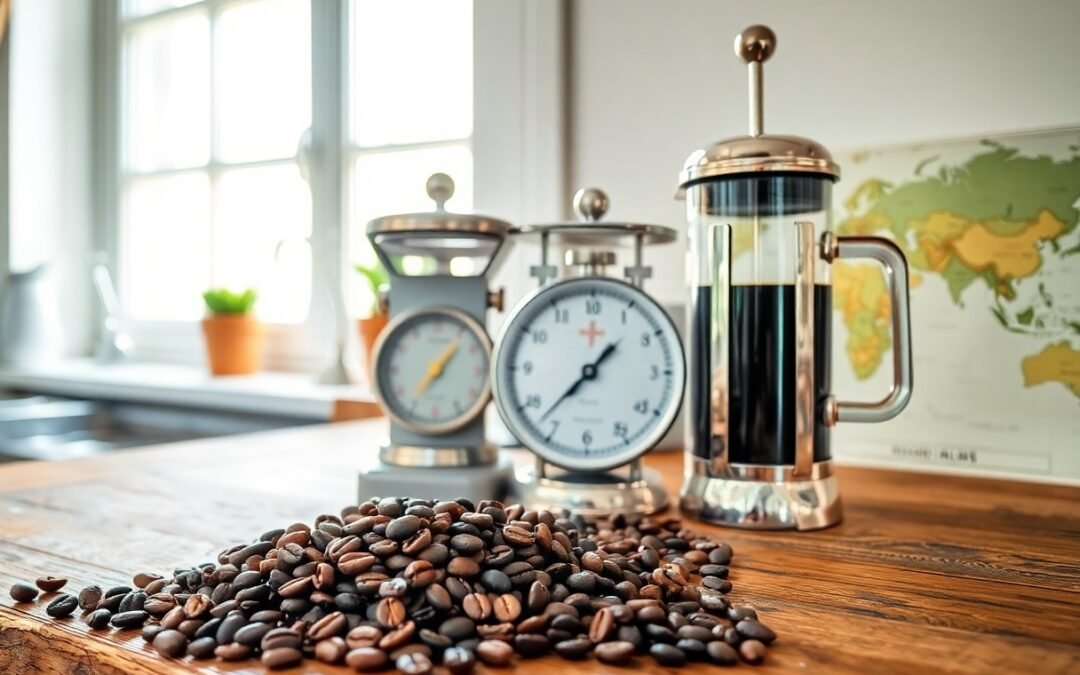Most home brewers overlook the profound impact that terroir has on the flavor profile of their favorite beverages. Understanding how environmental factors like soil, climate, and region influence the ingredients you use can elevate your brewing craft. As you explore the unique characteristics of different origins, you’ll discover how they contribute to crafting a cup that is not only sophisticated but also reflective of its source. This guide will illuminate the ways you can experiment with terroir to enhance your brewing experience at home.
The Genesis of Terroir: What Makes It Essential?
Terroir embodies the unique characteristics imparted to your brew by the land, climate, and local practices. This concept is fundamental in creating distinctive flavors, as every ingredient—from hops to grains—absorbs its surroundings. Terroir thus shapes the essence of your brew, elevating a simple concoction into a complex experience that reflects its origins.
Defining Terroir in the Context of Brewing
In brewing, terroir refers to the interplay of environmental factors and local traditions that define the taste and aroma of your beer. Elements such as soil type, water chemistry, and regional climate influence the growth and development of ingredients. This complexity ensures that each brew tells a story of its geographic origins and cultural influences.
Historical Influence of Location on Flavor Profiles
Your choice of brewing ingredients closely ties to geographical roots, shaping the flavor profiles across various styles. Regions like Germany, Belgium, and the Pacific Northwest each showcase distinctive characteristics linked directly to local farming practices and climatic conditions. For instance, German pilsners exhibit crispness attributed to the mineral-rich waters of the region, while Belgian ales often draw from unique yeast strains native to their historic breweries. This rich tapestry of location-driven flavors offers an opportunity for you to explore and experiment in your home brewing.

The Sensory Symphony: How Terroir Shapes Aromas and Tastes
Your brewing experience is elevated as terroir intricately weaves aroma and taste into a harmonious symphony. Unique geographical attributes imbue ingredients with distinct characteristics, creating a sensory journey through diverse flavor profiles. From the floral notes of a high-elevation coffee bean to the earthy richness of barley grown in nutrient-dense soil, the essence of the land is translated into your cup, making each brew a reflection of its origins.
The Role of Soil Composition in Flavor Complexity
Climate Variability: From Temperature to Precipitation
Climate Variability: From Temperature to Precipitation
| Factor | Impact on Flavor |
|---|---|
| Temperature | Affects growth rates, influencing sugar and acidity levels. |
| Precipitation | Modifies nutrient uptake; irregular patterns can lead to stressed plants with altered flavors. |
| Sunlight | Increases aroma compounds, enhancing the sensory profile of the brewed beverage. |
Climate Variability: From Temperature to Precipitation
| Climate Factor | Brewing Implication |
|---|---|
| Extreme Heat | Can cause early ripening in coffee, reducing acidity and balancing flavors. |
| Sustained Drought | Increases bitterness in grains and can result in lower yields, affecting overall flavor complexity. |
| High Humidity | Can promote fungal growth, impacting quality and flavor of the crop. |
Crafting Brew with Intent: Selecting Ingredients Based on Terroir
A thoughtful approach to ingredient selection transforms your home brewing journey. By aligning your choices with the nuances of terroir, you enhance flavor complexity and authenticity. Recognizing the local environment’s influence enables you to select grains, hops, and other components that resonate with your specific region, thus crafting a beer that reflects its roots.
Sourcing Local Grains and Hops for Authenticity
Your choice of local grains and hops adds depth and authenticity to your brew. Sourcing ingredients from nearby farms not only supports local agriculture but also introduces unique flavor profiles that embody the region’s climate and soil. The subtle variations in malt and hop characteristics can unveil a story in every sip, giving your beer a sense of place.
The Impact of Water Quality and Mineral Content
Water quality dramatically affects your brewing process and end product. Different mineral compositions, such as calcium, magnesium, and sulfate levels, alter everything from bitterness to mouthfeel. A well-balanced water profile can enhance hop flavors or malt sweetness, ensuring you achieve your desired taste. Assessing your local water’s characteristics can help you make informed adjustments, such as adding brewing salts to fine-tune the final profile.
Specific minerals in your water can enhance or mute various flavors. For instance, higher calcium levels improve the crispness of your beer and contribute to a fuller mouthfeel, while elevated sulfate levels can accentuate hop bitterness. Conversely, lower bicarbonate levels are beneficial for lighter beers, as it preserves the delicate flavors. Understanding your water’s profile allows you to manipulate your brewing process effectively, ensuring a refined and balanced cup that reflects your chosen terroir.

Brewing Techniques Tailored to Terroir’s Unique Offerings
Understanding your local terroir allows you to craft beer that highlights its natural characteristics. By tailoring brewing techniques to your region’s unique offerings—such as local water profiles, specific malt types, and seasonal ingredients—you can create a sophisticated cup that reflects the area’s essence. Fine-tuning factors like temperature, timing, and water chemistry enables you to unlock complex flavors and aromas, making your home brewing experience not just a process, but a celebration of your surroundings.
Adapting Brewing Methods to Reflect Regional Variations
Your brewing methods should resonate with the characteristics of your local ingredients. For instance, if you’re using water rich in minerals from a specific region, adjusting your mash temperature can emphasize those unique characteristics. Similarly, opting for local hops or grains dictates how you extract flavors during the brewing process, allowing you to achieve a balance that pays homage to your terroir. Emphasizing these local nuances in your techniques creates a stronger connection within each brew.
Experimenting with Fermentation: Yeast Selection Matters
Yeast selection significantly influences your beer’s flavor profile and reflects the characteristics of your terroir. Different yeast strains express varying flavors and aromas, meaning that choosing local or seasonally available yeasts can enhance your brew’s regional identity. For example, using a farmhouse yeast strain known for its fruity esters can bring forth the essence of your local climate, while other strains may pronouncedly emphasize malt or hop characteristics.
Delving into yeast selection allows you to explore not only the traditional strains but also wild yeasts that thrive in your area’s unique environment. For instance, if you live near an orchard, using yeast sourced from local fruit can impart subtle fruity notes that are distinct to your region. Likewise, experimenting with different fermentation temperatures and times can reveal complexities in flavor that showcase the character of your locale. Each choice in yeast opens the door to a multitude of flavors, making your brewing a true reflection of your terroir.
Cultivating a Personal Connection: The Importance of Place in Home Brewing
Your brewing journey becomes more profound by embracing the significance of place. Sourcing ingredients from your local environment not only supports regional agriculture but also enhances your brew’s identity. Whether it’s selecting malt from a nearby farm or using local water that carries unique mineral content, the flavors reflect the character of your surroundings. This connection nurtures a deeper appreciation for both your craft and the local ecosystem.
The Art of Storytelling Through Your Brew
Engaging with Local Breweries and Craft Communities
Engaging with local breweries and craft communities can unlock a wealth of resources and inspiration for your brewing practice. Networking with seasoned brewers can provide you with valuable tips on ingredient sourcing, fermentation techniques, and flavor experiments. Many communities host farmer’s markets or events where you can find exclusive local hops or grains, further diversifying your brewing palate. Moreover, participating in competitions or collaborative brews can enhance your skills and expand your brewing horizons, making each cup a unique reflection of shared passion and regional pride.
Final Words
As a reminder, terroir profoundly impacts the brewing process, influencing the flavors and aromas in your cup. By paying attention to the origin of your ingredients—such as the water, grains, and hops—you can harness local characteristics to enhance your brewing experience. Understanding how environmental factors affect your components allows you to craft a sophisticated cup at home that reflects your unique taste preferences. Embrace these elements to elevate your brewing skills and enjoy a more nuanced flavor profile in each sip.
FAQ
Q: What is terroir and how does it relate to brewing?
A: Terroir refers to the unique characteristics of a specific geographic region, including soil, climate, and topography, which can influence the taste and quality of ingredients used in brewing. It affects the flavor profile of ingredients like hops, malt, and even water, resulting in distinct brews.
Q: How can local water quality impact the brewing process?
A: Water quality, including its mineral content, pH level, and source, significantly influences the extraction of flavors during brewing. Certain minerals can enhance beer profiles, while others may lead to undesirable tastes. Understanding local water characteristics allows for adjustments in recipes to achieve desired flavors.
Q: In what ways do different soil types affect brewing ingredients?
A: Soil types can affect the nutrient availability for barley and hops, influencing their growth and development. For example, rich, fertile soils can produce richer malt flavors, while sandy soils might yield a lighter taste. The soil composition thus indirectly shapes the flavors available for brewing.
Q: How does climate influence the brewing process?
A: Climate affects the growing seasons and conditions for grains and hops. Temperature, rainfall, and sunlight impact the sugar levels and aromatic compounds in the plants, leading to variations in flavor. Brewers must adapt their techniques based on the seasonal characteristics of their local environment.
Q: Can home brewers replicate the concept of terroir?
A: Yes, home brewers can embrace terroir by sourcing local ingredients, such as grains, hops, and water, to create unique beer profiles that reflect their region. Experimentation with local resources allows brewers to capture the essence of their area’s specific terroir in each batch they produce.

